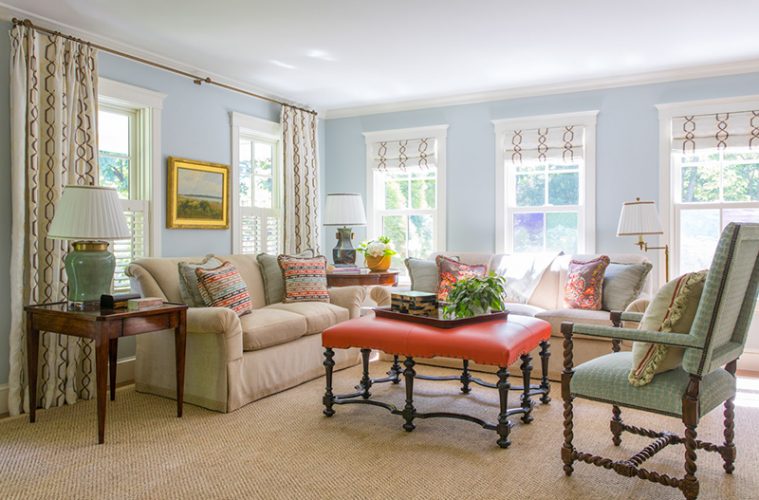What they bought was a historic cottage-turned-farmhouse, which had been added onto over time. What they envisioned was a home whose design fulfilled years’ worth of accumulated wishes. What they achieved was a seaside charmer that delights in all four seasons.
I’m all about renovating houses,” admits the owner, who, along with her husband, enjoys the challenge of finding the potential within existing structures. “It’s something we find really fun.”
The couple has lived in Manchester, in a few different places, for 30 years. “We moved into one home that was sort of a builder’s nightmare, fixed it up, sold it, and moved into a beautiful 1860 summer home that we renovated from top to bottom,” she relates.
When friends approached them about buying their 1820 farmhouse, set on a four-and-a-half-acre lot, they found themselves drawn to the opportunity. The property’s amenities, including its proximity to town, the train, and the beach, were hard to pass up. A path leading down to the beach that begins right across the street was an added bonus.
Upon purchase, the home consisted of an existing street-front cottage with an added wing off the back. However, the owners’ wish list, which included a large kitchen, family room, mudroom, garage, and master suite, meant that a combination renovation/addition project was in order. The pair turned to friend and architect John Olson, principal of Manchester–based Olson Lewis + Architects, to realize their vision.
They wanted the house to fit them, almost as if they were building it from scratch,” says Olson. Making the existing structure, with its predominance of small spaces, feel new again was no small feat. The process involved preserving the integrity of the historic structure while thoughtfully adding onto it, opening up spaces to one another, and infusing both old and new rooms with as much light as possible.
Luckily for the homeowners, Olson was up to the task. “He did an amazing job,” credit the owners. “He asked us about our goals and actually walked through our former house with us to see what we did and did not like about it. He also worked really hard to give us the same level of detail we had in our last home.”
The generous lot size could accommodate a variety of transformations, including a greater setback from the street, but both Olson and the owners, mindful of the home’s historic village location, decided to preserve the original Greek Revival-style façade. “We kept the cottage portion and worked backwards,” explains the architect.
A formal living room, which stretches along the front of the home, and an adjacent dining room constitute the “cottage portion,” with their modest eight-foot ceilings and minimal woodwork. Moving toward the back of the house and the new living spaces, a step-down expands the ceiling height to a more generous nine feet three inches. (“The added height is perfect because we have a very tall family,” laughs the owner.) Also, Olson introduced more elaborate millwork into the new rooms, mimicking details typical of a turn-of-the-century Shingle-style cottage.
In order to give the owners all of what they wanted, Olson cleverly turned the rectangular home into an L, with the living room, dining room, pantries, kitchen, and office space in one wing and a mudroom, sunroom, and garage comprising the section running parallel to the street. Nestled in the L’s crook is an expansive family room, open to both the kitchen and the rear patio (and pool beyond).
The kitchen is a chef’s kitchen—the owner loves to cook and entertain. “It was designed so that I could be cooking but also be part of the party,” she says. “We also wanted it to have an older look, so we chose period details like beautiful Carrera marble for the countertops and backsplash.” The adjoining office enjoys garden views: “That’s where you’ll often find me,” she says.
Admittedly, the couple’s preferred spots change depending on the season. The front living room, with its warm orange and brown tones, is a favorite post on winter days, as is the sunroom for its afternoon light (Isabelle, the family’s English bulldog, likes it there, too). But come summer, the family lives in the back of the house, enjoying the light and airy atmosphere, garden views, and outdoor living spaces.
John did an amazing job of creating big, open rooms that don’t feel too cavernous when it’s just the two of us,” explains one of the owners. And when their three grown sons are home, sometimes with friends, the house accommodates the larger crowd easily, with help from a large hangout space/game room above the garage.
One part summer home, one part year-round family compound, the finished renovation graciously accommodates alternating seasons and varying guest counts. “We love that it is filled with comfortable spaces,” add the owners. “It’s the perfect marriage of formal and informal, old and new.”
Article appears in the Fall 2015 issue of Northshore Home magazine.

